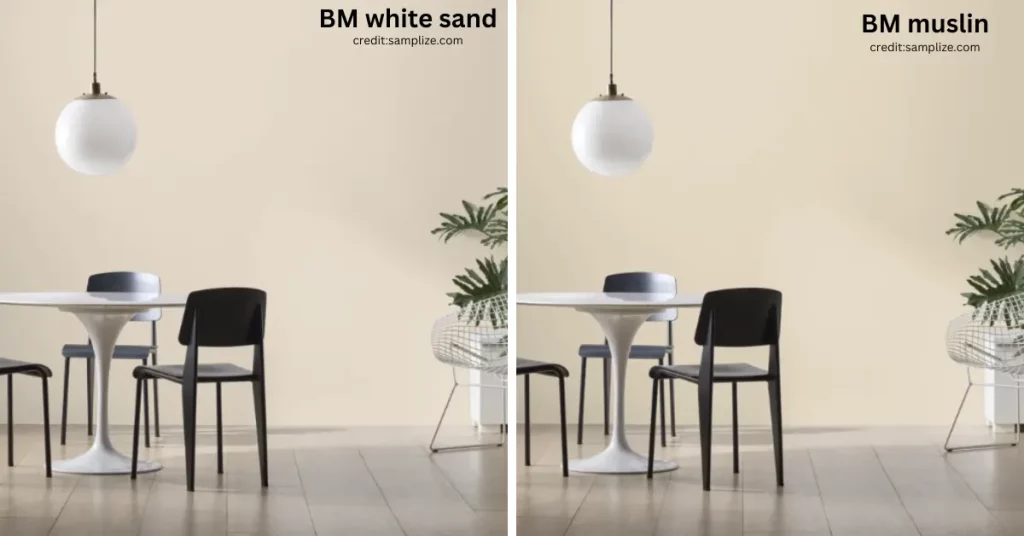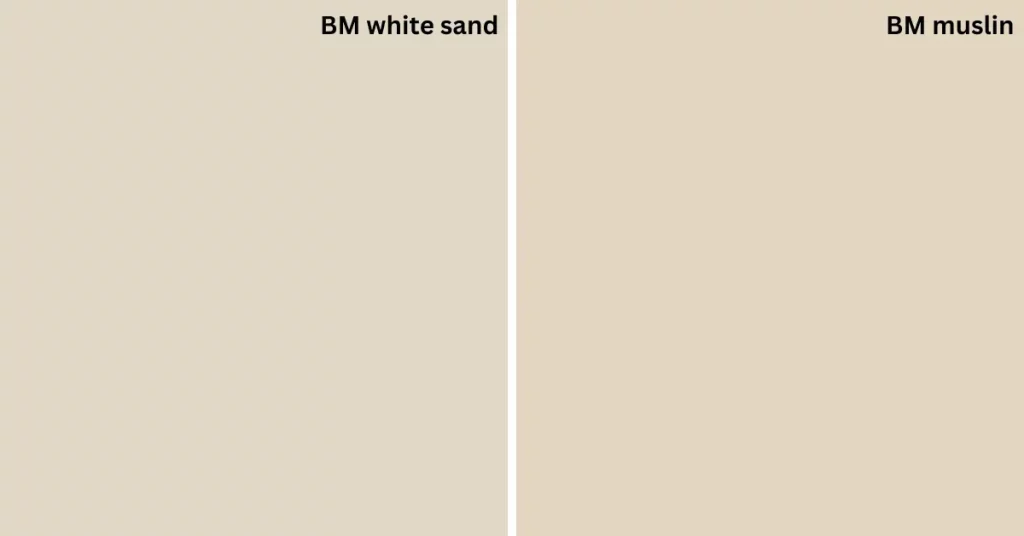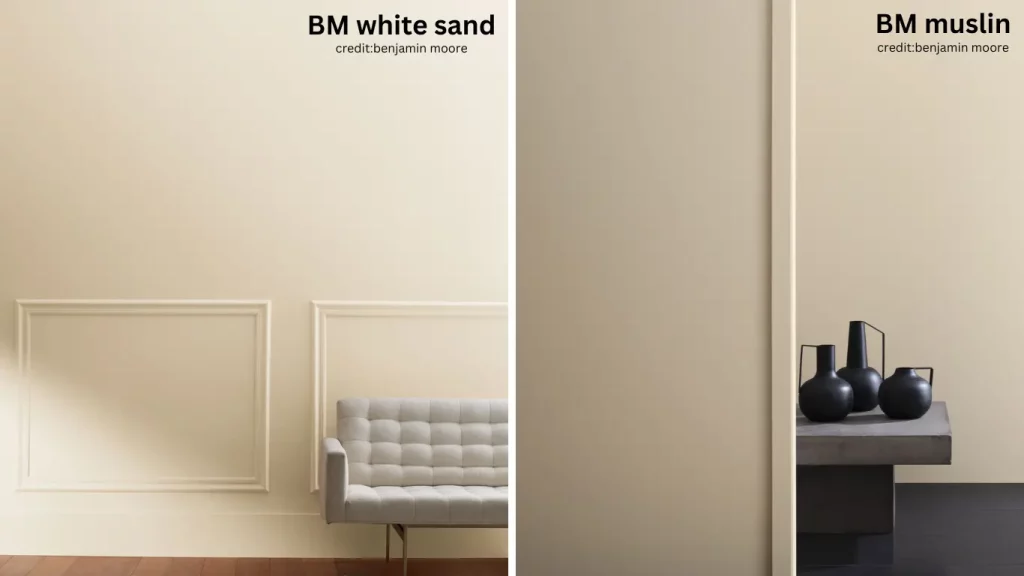Are you looking for the perfect white paint to transform your room? With so many choices, it can be hard to decide which is the best option. If you’re stuck between Benjamin Moore White Sand and Muslin, you’ve come to the right place.

Both of these paints offer different color hues, finishes, and application processes, as well as varying levels of durability and coverage areas.
We’ll explore all of these details in-depth so that you can decide which option is best for your project. From safety protocols to drying time, keep reading to learn more about the differences between Benjamin Moore White Sand vs Muslin.
Comparison between Benjamin Moore White Sand and Muslin Paint Colors
When looking for the perfect paint color to bring a warm, inviting atmosphere to your home, you may want to consider two options: Benjamin Moore White Sand and Muslin. Both colors are neutral and offer a timeless aesthetic, but they feature subtle differences that may influence your decision. Benjamin Moore Alabaster vs White Dove is a different type of paint that you check before diving into this comparison.

01: Color/Shade
White Sand is lighter with warm gray greige undertones, while Muslin is slightly darker with more greyish tones.
Both colors will look white when painted on large walls and ceilings, but the differences become more noticeable when they are used in smaller areas, such as trims and door frames.
White Sand has a warmth that adds to the overall brightness of any room, while Muslin has a subtle gray undertone that creates a slightly darker and moodier atmosphere.
02: Sheen/Finish Level
Benjamin Moore White Sand and Muslin can be purchased in different sheen or finish levels. White Sand can be bought in flat, eggshell, satin, semi-gloss, and high-gloss. Muslin can also be purchased in flat, eggshell, satin, and semi-gloss finishes, but it does not come in high-gloss options.
Flat finishes provide a matte look without any shine or gloss and are perfect for hiding imperfections on walls. Eggshell finishes add a slight sheen to the walls, which makes them easier to clean than flat finishes.
Satin finishes have more sheen than eggshells but retain some of the matte looks, which helps keep imperfections hidden. Semi-gloss finishes give off quite a bit of shine, which highlights architectural details. At the same time, high gloss provides an even more significant glossy effect often used to accentuate certain features, such as doors or cabinets.

03: Application Process
When applying Benjamin Moore White Sand or Muslin Paint to walls or other surfaces, there are some crucial steps to follow for best results regardless of their sheen levels. You should always start by preparing your surfaces by cleaning them thoroughly from dust and dirt particles to ensure proper paint adhesion later on.
Then you should apply primer according to the manufacturer’s instructions before painting with Benjamin Moore products. You don’t risk having them peel off later due to improper adhesion caused by lack of primer use.
After primer application, you should choose your desired finish level (flat, eggshell, satin, etc.) depending on your preference or room’s requirement for extra durability against wear and tear (for example, kitchen cabinets).
Finally, use quality rollers or brushes according to the manufacturer’s instructions (smaller sizes for trim work), so ensure all areas get covered evenly without leaving any brush marks behind before the paint dries up completely. This will save you time spent sanding later.
04: Durability and Maintenance
Benjamin Moore White Sand has a long-lasting finish that resists chips and scratches. It is also moisture resistant, making it ideal for high-traffic areas like kitchens and bathrooms. Its superior durability makes it a great choice for high-traffic areas where frequent maintenance may be necessary.
On the other hand, Muslin paint is not as durable as White Sand, but its finish is surprisingly resistant to chips and scratches. Its ability to hold up well in humid environments makes it an excellent choice for residential bathroom and kitchen applications. But, its lack of moisture resistance requires more frequent maintenance than White Sand Paint.
05: Potential Coverage Areas and Drying Time
Benjamin Moore White Sand is a great choice for larger coverage areas like walls and ceilings due to its superior coverage rate when compared to Muslin Paint. In addition to this, it dries fairly quickly so you can get your project completed quickly without having to wait too long for the paint to dry.
On the contrary, Muslin Paint does not offer the same coverage or drying time as White Sand. It typically takes longer for Muslin Paint to dry since it does not have the same fast-drying properties as Benjamin Moore’s product. Therefore, if you are looking for a quick turn-around on projects with large coverage areas, then Benjamin Moore’s White Sand would be your best bet.
06: Safety Protocols
When using either Benjamin Moore White Sand or Muslin Paint, safety should always be the top priority when working with these products. Both paints contain volatile organic compounds (VOCs) that are hazardous if inhaled over prolonged periods.
As such, before starting any project involving either of these paints, proper safety protocols should always be followed, such as wearing protective eyewear and breathing masks while painting in well-ventilated areas.
Moreover, both paints should always be stored away from direct sunlight or extreme temperatures that could lead to formulation changes which could ultimately cause the reduced performance of these products once applied on surfaces intended for painting jobs.
What Is the LRV of Benjamin Moore White Sand?
The Light Reflectance Value (LRV) for Benjamin Moore’s 964 White Sand is 68.07, as determined by its RGB value of 225, 214, and 197; which corresponds to a HEX code of #E1D6C5. This particular LRV is considered quite light and is usually associated with delicate shades of white, like ivory or cream.
It can also be combined with other lighter colors to create a tranquil and soft atmosphere in any room. The LRV will determine how much natural light will be reflected off the paint color, so it’s important to understand how this value works when selecting an appropriate paint color.
For example, if you want a bright-colored wall that allows more natural light into the room, you should go for a higher number of LRVs. But if you prefer something more muted and calming, then choose something lower on the LRV scale, such as Benjamin Moore’s 964 White Sand.
What Is the LRV of Benjamin Moore Muslin?
The Light Reflectance Value (LRV) for Benjamin Moore’s Muslin is 67.99, as determined by its RGB value of 88.24, 83.92, and 75.69. This particular LRV shade is one step darker than 964 White Sand, making it perfect for creating a subtly inviting and soft atmosphere in any room.

It still has enough light reflectance to allow natural light into the space without being too harsh or bright while at the same time offering some privacy due to its slight darkness. If you’re looking for something sophisticated yet simple, then Muslin would be an excellent choice.
This one is perfect for modern homes with neutral tones throughout. With its timeless appeal and subtle complexity, Muslin offers character and warmth in any living space.
Get the Perfect Paint Job with Benjamin Moore White Sand or Muslin
To summarize, Benjamin Moore White Sand and Muslin both offer a wide range of features that make them great options for any painting project. While they have some similarities in color hues and finishes, plenty of differences set them apart.
From safety protocols and application process to the coverage area and drying time, understanding these distinctions can help ensure that you select the best choice for your particular needs.
So, if you’re trying to decide between Benjamin Moore White Sand vs. Muslin for your next painting project, we hope this article has given you the knowledge needed to make an informed decision.

S. Pushon is a paint expert, self-taught artist, and currently working as an adviser in the paint industry as a Quality Improvement and Development Assistant.
An artist by heart, he draws remarkable art pieces and as a professional paint industry individual, he seeks the insight and shares with enthusiasts. Read more…
